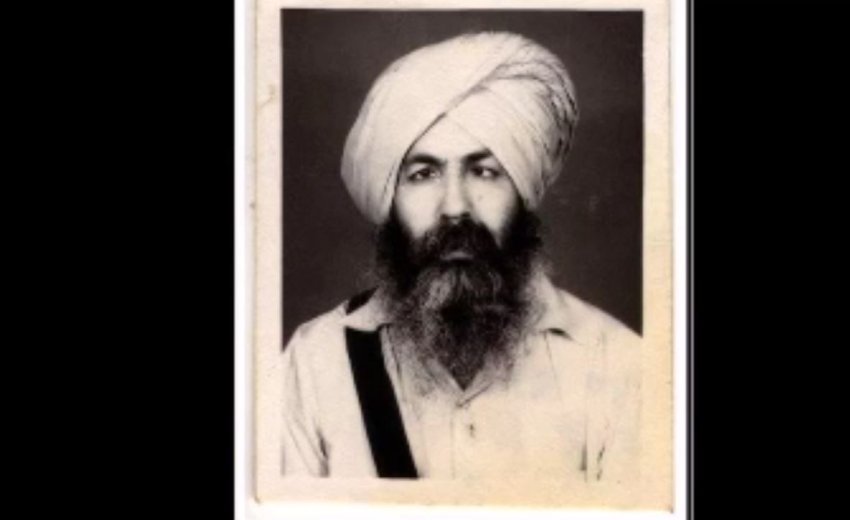My introduction to Professor Harinder Singh Mehboob’s work occurred in Kansas in September 1993. I found the opening paragraphs of ‘The Rider of the Blue Steed” incredible: a fresh, endearing, and intelligent approach to the “life-movement” of Guru Gobind Singh Sahib. I would meet him four years later on the Vaisakhi day of 1997at his home in Panjab. As a contemporary personality, I was most impressed with his religious lyrical innocence, unbridled devotion to the Sikh heritage and its institutions, unparalleled evaluation of world literature, uncompromising intellectual honesty and a dervish humility and simplicity. My continuous journey through his works is best expressed as the gold standard for exploring aesthetics, history, philosophy, poetry, folk culture, metaphysics, and contemporary diction – and all at the same time.
In the Sikh world, he shall be held in highest esteem not solely as a literary figure, but as a Sikh who inspired Surat – state of consciousness – a way of existing among everything which surrounds us that most can only hope to glimpse during those sacred moments in life; the state in which “The Way of the Peaceful Warrior” continuously is ‘Jo hai so hai.’ Poetry came out of him infused with such genius and perfection as to belie human origin.
Prof. Mehboob was a pure instrument of the Guru – a rabab (rebeck) upon which Guru Nanak Sahib plays an exquisite sabad (infinite wisdom). In his vast outpouring of style, ideas, and images such as khalas-kudrat, vismad-naksh, and vijei-tark, he not only captured the whole of the Sikh inspiration, but also transformed it into an exquisite illustration of the Sikh spirit. The most banal experiences were cast in the light of universal truths; the ordinary life of an individual – crowded, busy, and full of uncertainty – is shown to be an elegant and necessary step on one’s journey of the ineffable Absolute.
Though he was a professor of English, Prof. Mehboob wrote his major works in Panjabi – demonstrating the pinnacle importance of articulating in one’s mother tongue. He was a product of the Marxist intellectual movement (a norm among Panjabi intellectuals), but embraced the Sikh thought and lifestyle after graduate studies. The ideological leanings, the progressive journey, and personal limitations are all were quite visible in his everyday life. After the 1984 genocidal killings of Sikhs in India he became particularly known for his Sikh activism. It is no secret that today’s most celebrated Panjabi poets used to go seek his remarks and approvals before publishing their work.
Prof. Mehboob did not simply pen ordinary books, he wrote multiple anthologies that re-defined and re-invigorated the South Asian literary world. His essays, both in English and Panjabi, were bold and insightful. His contributions generated thought-provoking discussions and debates across Panjab’s borders.
To appreciate “Jhana di Rat” fully, one must delve into it often for the rewards commensurate. The reader who returns to the words finds himself steeped in its beauty and in its depths of sentiment. I felt as if I was lost in the streets of Lahore; I re-lived the carefree moments and worriless sleep at Nankana Sahib. The love for Panjab and its co-religionists is gracefully articulated in the old glory of multi-cultural des (nation); a culture born through the Grace of the Guru, and able to live in ‘Harmony in a World of Difference.’ And lastly, lest we forget, the allegorical depiction of the 1984 ghallughara (genocide) in a poem ‘nind da katal ate shahid da ghazab’ is dreadfully powerful. In fact, it invited the wrath of the Indian state which targeted the Professor for elimination.
In kind, I return to “Sahije Rachio Khalsa” again and again in order to more properly absorb each nugget of information and insight. It is a work rich with Sikh traditions and feelings and with the author’s often religiously powerful “mystic logic.” Its poetic prose is exemplified by the believer’s conviction. The elaborate explanations that Prof. Mehboob weaves in throughout are more than suffice to satisfy the elements challenging the Sikh traditions from within, as well as from well-planned external attacks. The vocabulary is large; frequently, the sentences are intellectually stimulating. I believe if this work were to be translated into English, it would establish the universalities of Sikh thought at a global level. It addresses the falsity, cleverness, and shortcomings of anti-Sikh theses, effortlessly constructs arguments against Sikhi which scholars studying Sikhs haven’t yet thought of, and then demolishes them with the fine lyrical balance of Sikh sensibilities. He highlights the grandeur of the Guru.
For me, “Ilahi Nadar de Painde” works its influence at the level of the soul, filtering, like the cry of the loon, through the subconscious. It is an unparalleled poetic rendition of life, love, and the Satigur. The epic is a spiritual flight that pierces through the heart and sends shivers throughout the body. It echoes the spirit and thought we encounter in the writings of the stalwarts like Bhai Vir Singh and Mahakavi Santokh Singh. I ought to delve even deeper into the first volume to feel the prophet-genius of Guru Nanak Sahib. I am saddened the second volume on Guru Gobind Singh didn’t see its completion by Prof. Mehboob; nonetheless, I await its publication.
Prof. Mehboob’s works were not the product of literary ambition, but rather should be viewed as acts of service. The religious and poetic traditions that produced Prof. Harinder Singh Mehboob, Bhai Vir Singh, and Prof. Puran Singh can be said to understand all of creation as providing the metaphors of Divine Qualities. Like the Sufi poets Abdur Rahman Jami and Jalaluddin Rumi, Mehboob’s poetry inhabits many dimensions of life simultaneously. While most poetry leads us through carefully arranged sentiment, Prof. Mehboob wrote from somewhere beyond this common realm of thoughts and feelings, as we know and define them today. His poetry is not so much the search for the immanent truth and knowledge, or some discovery to be made in the outer world, but an elaboration of an instant 'hereness,' the immediate inner song of experience that floods this world but is not of it. It is an ecstasy of wisdom that flows into words, sounds, and images. Prof. Mehboob’s labor of love is the experience of the whole as well as the parts.
The magnificence of Prof. Mehboob’s poetry heartened my faith, his magical words and transcending love arouses an unquenchable hunger in me. Within the folds of his words, I gain entrance to a hidden chamber; I hear whispers that are ancient, yet intimate; I behold an endless love story between an individual being and the Satigur (the perfection).
An eccentric resident of ‘bhutvara’ has embarked on his journey to the world hereafter, but Prof. Mehboob’s genius made its everlasting impression on this earth. I consider it my great fortune to have visited Prof. Mehboob at Garhdivala several times, listened to his lectures throughout the land of the five rivers, and enhanced my own outlook with the valuable perspectives of this great teacher.
18 February 2010
Harinder Singh is a co-founder of the Sikh Research Institute. He addresses the Sikh and the Panjab issues throughout the world. His passion is to learn and share the Sikh culture.

